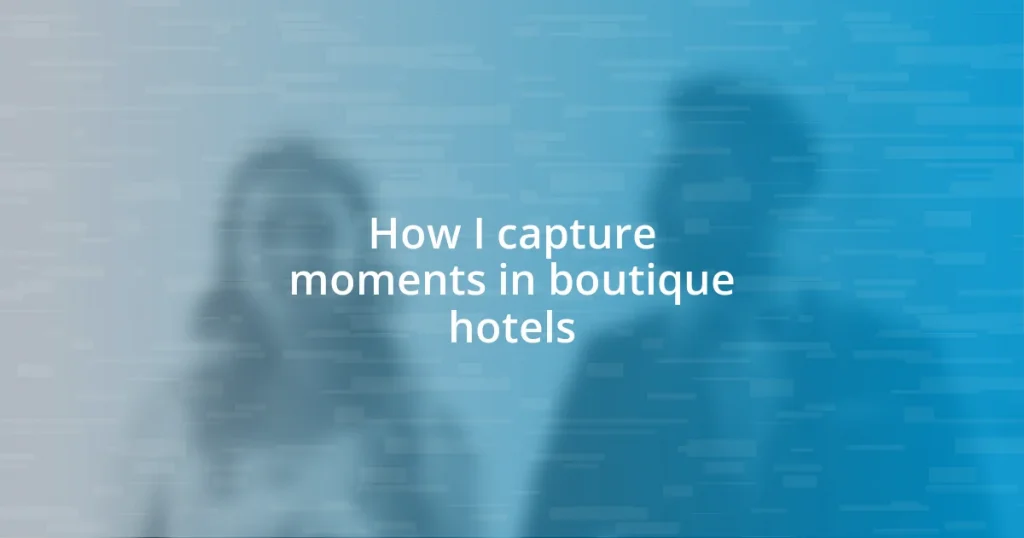Key takeaways:
- Boutique hotels provide an intimate experience, often reflecting local culture through personalized touches and unique decor.
- Utilizing natural light and focusing on character and details can significantly enhance the photography of hotel interiors.
- Sharing personal storytelling from boutique hotel stays fosters connection and evokes emotions, transforming individual experiences into shared journeys.

Understanding boutique hotel charm
Boutique hotels exude a unique charm that often feels more intimate than larger chains. I remember staying in a small, family-run hotel in Paris, where every corner told a story through its carefully selected decor. Isn’t it fascinating how such spaces can make you feel like you’re part of something special rather than another guest passing through?
These hotels often reflect the local culture and history, creating an atmosphere that’s inviting and warm. During my visit to a boutique hotel in Mexico, I discovered that the vibrant colors and handmade pottery weren’t just aesthetic choices—they represented the region’s rich artisan heritage. How can a simple design choice evoke such strong connections to a place and its people?
Moreover, the personal touches in boutique hotels—like handwritten notes from the staff or custom recommendations for local attractions—can turn a straightforward stay into a memorable experience. I found it remarkable how one hotelier, upon learning it was my birthday, arranged a small surprise celebration, making me feel honored and appreciated. Isn’t it those heartfelt gestures that can truly capture the essence of boutique charm?

Tips for capturing unique interiors
Capturing the unique interiors of boutique hotels starts with understanding the space’s character. When I walk into a room adorned with eclectic art pieces, I take a moment to breathe it in and reflect. For instance, while visiting a charming boutique hotel in Lisbon, I was struck by a wall mural that represented the city’s history. This inspired me to frame my shots around such focal points, allowing the art to tell its own story alongside the overall design.
Lighting plays a crucial role in showcasing interior beauty. Soft, natural light can create a warm and inviting atmosphere, while dramatic shadows can add depth. I remember photographing a cozy library in a boutique hotel nestled in the mountains, where the afternoon sun filtered through large windows, casting gentle patterns on the wooden shelves. Choosing the right time of day not only enhances the textures of the space but also evokes a certain mood that can transform an ordinary shot into something extraordinary.
Lastly, don’t be afraid to get up close and personal with the details. I often find myself crouching down to capture the intricate patterns of handwoven rugs or the delicate craftsmanship of vintage furniture. During a stay at a small hotel in Kyoto, the tiny, elegant tea sets caught my eye, prompting me to take a macro shot that revealed their exquisite details. This approach allows me to highlight the unique elements that make each hotel interior truly special.
| Tip | Description |
|---|---|
| Focus on Character | Identify key features that reflect the hotel’s personality, like art or architectural details. |
| Utilize Natural Light | Capture the interplay of light and shadow to enhance textures and atmospheres. |
| Highlight Details | Get up close to showcase unique craftsmanship and intricate designs. |

Highlighting hospitality through storytelling
The stories behind the hospitality at boutique hotels are often as captivating as the physical surroundings. For instance, during a stay at a quaint seaside retreat, I had the chance to meet the owner, who shared tales of how her grandparents had built the hotel from the ground up. Hearing her describe the effort and passion infused in each brick made my stay more meaningful. Moments like these remind me that every corner has a narrative waiting to be uncovered.
Storytelling in hospitality often involves small, impactful gestures. The thoughtful details left by staff can transform a regular experience into something heartfelt. Here are some examples that illustrate how storytelling enhances the guest experience:
-
Personalized Recommendations: A local barista offered me a hand-drawn map to the best coffee spots, making me feel like a privileged insider rather than just another traveler.
-
Cultural Experiences: I was invited to participate in a cooking class focused on traditional local cuisine, which not only taught me about the food but also about the community’s history and values.
-
Handwritten Notes: Finding a note from the staff wishing me a wonderful adventure for the day added a personal touch that lingered long after my stay.
Savoring these experiences is what makes boutique hotels a treasure trove of storytelling moments, each one heightening the emotional connection between the guest and the space.

Utilizing natural light effectively
Natural light is often the unsung hero of interior photography, and I’ve found it to be a game-changer. For example, during a stay at a seaside boutique hotel, I woke up early to catch the sunrise pouring golden light into the room. The way it illuminated the soft linens and created a dance of shadows on the walls was nothing short of magical. Have you ever noticed how the same space can feel completely different depending on the light?
I’ve learned that timing is everything when utilizing natural light. In a charming Parisian hotel, I found that the late afternoon provided the perfect soft glow to highlight the intricate molding on the ceilings. It was fascinating to see how the shadows deeply defined the architectural elements, adding depth and drama to each shot. This experience taught me that waiting just a little longer for the right light can transform mundane photos into vibrant storytelling pieces.
It’s also about being aware of your surroundings and how light interacts with them. During a stay in a rustic hotel by the forest, I positioned myself near a window where light streamed in, bouncing off the rustic wooden beams. This angle not only brought warmth to the photo but also created a cozy, inviting atmosphere that made viewers feel they were right there with me. Have you ever captured a moment that felt like it was bursting with life simply because of the way the light played? Trust me, those moments are worth chasing!

Creating a cohesive visual narrative
Creating a cohesive visual narrative is all about weaving together distinct images that tell a unified story. I remember staying at a boutique hotel nestled in the mountains, where the views were breathtaking. As I took photos of the outdoor deck, the mist swirling through the trees pulsed with a quiet magic. I aimed to capture not just the stunning landscape but also the feeling of serenity that enveloped me. By planning shots that mirrored each other in mood and style, I felt I created a visual thread connecting those serene moments to the bustling life inside the hotel.
In my experience, consistency in editing is key to a cohesive narrative. After a delightful stay at an art-themed hotel, I had a treasure trove of images that ranged from vibrant murals to cozy reading nooks. I decided to apply a warm filter across the collection, which not only enhanced the inviting atmosphere but also united the diverse moments into a single story of artistic escape. Have you ever looked back at photos and wished they felt more connected? I certainly have, and that realization drives me to be intentional with my editing choices.
Choosing a consistent focal point can also anchor your visual narrative convincingly. At a coastal boutique hotel, I focused on capturing the unique vintage decor throughout – from quirky lamps to handcrafted tables. Each photograph I took was purposeful, showcasing not only the charm of the space but also creating a personal diary of my experience there. It made me think: what details define your experience in a similar setting? Finding and emphasizing those elements can elevate your storytelling, turning a series of snapshots into a rich tapestry of memory.

Sharing your boutique hotel experiences
Sharing my boutique hotel experiences often feels like stepping into a treasure chest of memories. I’ll never forget my stay at a quaint hotel in a historic town where every corner whispered stories of the past. I was so taken by the unique decor that I began sharing snippets on social media, capturing the plush velvet curtains and intricate tile work. It was fascinating to see how friends and followers resonated with my images. Have you ever realized how a photo can spark a conversation?
One of my favorite moments was during an escape to a boutique hotel by the lake. I used my phone to document the serene sunrise over the water, the way the light shimmered on the surface, creating a canvas of colors. I shared that moment with a simple caption about finding peace in nature, and it ignited a flood of comments from others expressing their longing for similar connections. It’s amazing how sharing these snippets evokes feelings in others, turning our experiences into shared journeys.
When I reflect on my travels, I’ve come to appreciate the importance of personal storytelling. Each hotel stay holds a piece of my narrative, and I love to craft blog posts that weave together emotions, descriptions, and photos. Writing about my boutique hotel experiences feels like inviting readers into a world that felt uniquely mine. That vulnerability fosters connection. Have you ever wondered how your stories shape the experiences of others? It’s a reminder that by sharing our moments, we bring others along on our adventures, sparking inspiration and curiosity.
















